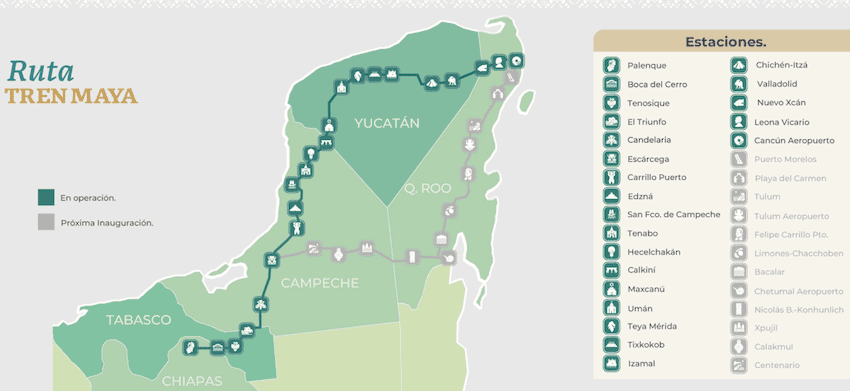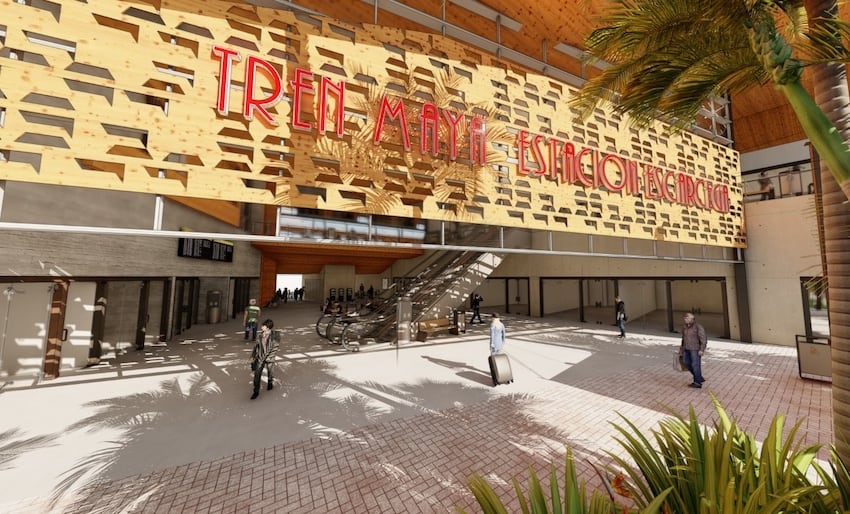The entirety of the Maya Train railroad will not be operational by the end of next month as previously announced, President Andrés Manuel López Obrador conceded on Friday.
Sections 1,2,3 and 4 of the 1,554-kilometer-long railroad — which link Palenque, Chiapas, to Cancún, Quintana Roo, via Tabasco, Campeche and Yucatán — were inaugurated in late 2023, while López Obrador had said that the remaining three sections would open on Feb. 29.

Speaking to reporters in Campeche on Friday, AMLO said that the only stretch of railroad that will open next month will be that between Cancún and Playa del Carmen, called Tramo 5 Norte — the northern part of Section 5.
The other sections that have not yet been completed are Tramo 5 Sur — the southern part of Section 5 between Playa del Carmen and Tulum; Section 6 between Tulum and Chetumal; and Section 7 between Bacalar and Escárcega.
Asked when the railroad will be 100% complete, AMLO responded: “I think in another two months, three months.”
He said that the government won’t be able to immediately inaugurate additional sections of the railroad, agreeing with a reporter that it would only be able to do so after elections on June 2, at which Mexicans will elect a new president and thousands of other officeholders.
López Obrador, who was in Campeche to officially open a state-owned “well-being gas station,” appeared to be saying that the inauguration couldn’t occur during the veda electoral — a period of pre-election silence that prevents politicians including the president from campaigning — although the real reason for postponing the opening could be that the railroad won’t be ready until much later than previously anticipated.
The inauguration of the entire railroad could conceivably benefit ruling Morena party presidential candidate Claudia Sheinbaum, a political protege of the president, who founded Morena.
Putting off the inauguration until after the elections gives the builders of the railroad — the army and private companies — more time to prepare it for operation.
Speaking to reporters earlier on Friday, Campeche government secretary José Urueta predicted that Section 7 of the railroad to Escárcega, a small city in the south of Campeche, wouldn’t be finished until May or June.

While four sections of the Maya Train railroad began operations late last year, many of the stations along that stretch have not yet been completed. Operations to date have not been as smooth as the government might have liked.
A train traveling between Cancún and Palenque was reportedly stopped for six hours last Friday, and passengers were eventually put on a bus and returned to the station at Cancún Airport. Several other delays have been reported since services began in late December.
Earlier this week, it came to light that steel and concrete pilings that support an elevated section of track between Playa del Carmen and Tulum pierce the roofs of limestone caves, where they pose a risk to the quality of subterranean water, according to experts.
Lopez Obrador says that both the construction and operation of the Maya Train railroad — a US $20 billion project — will help generate economic prosperity and well-being in the five states through which it runs. It connects cities and towns in Tabasco, Campeche, Yucatán, Quintana Roo and Chiapas, giving passengers access to less-visited parts of Mexico’s southeast.

López Obrador believes that many tourists who fly into Cancún will use the train to head to inland destinations on the Yucatán Peninsula — an area with numerous archaeological sites, pretty colonial cities such as Valladolid and Izamal in Yucatán and plentiful cenotes, or natural sinkholes, among other attractions.
However, it remains to be seen how much demand there will be in the long term for tourist services on the railroad, which is also set to be used by freight trains at some point in the future.
As of Jan. 8, the train had transported 15,500 people on 144 trips, averaging 800 people per day, mostly national tourists and local residents.
Tourism Minister Miguel Torruco said earlier this week that the Maya Train will help lure international tourists to Mexico in 2024, with some 42 million predicted to visit the country this year.
With reports from Reforma and El Universal
